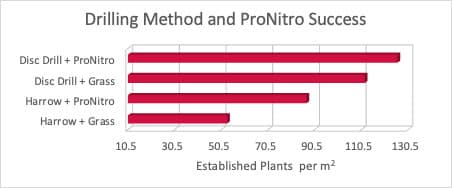Overseeding presents a real opportunity to restore production in tired or damaged swards. It is also a way to get a rebound in forage yield in a low-cost, energy saving and climate-friendly way. The drilling technique saves money for expensive fuel and the loss of CO2 from the seed bed preparation is limited to a minimum.
When the sward becomes open allowing weeds and unsown species to invade, overseeding will help to restore and maintain productivity by increasing both yield and quality. The loss of 1 tonne DM/ha @ 11MJ/ kg DM equates to 11000 MJ. This is the difference between success and failure in forage production!
No matter how good the grassland management is, there will be a decline in output and an increase in weed species present over time. From year one a yield decrease of 8-10% is normal, which unfortunately is also associated with a decline in forage quality. Without any doubt sward renewal is a golden option. In many cases however, it is not practical nor economical to establish swards with a full reseed. Instead, an overseeding can successfully improve both yield and quality of the grassland at 25% of the normal cost. The main advantages of overseeding grassland are:
- Increased production and extended grazing season
- Improved animal performance, profitability and digestibility
- Depression of non-productive grasses and broad-leaved weeds
- Introduction of newer improved varieties and better disease resistance
- The inclusion of clover will improve protein content, and potentially save on purchased nitrogen
What yield improvements can be achieved?
Overseeding increases not only forage yields but also the forage quality. Such improvement translates into increased milk- and meat yields without extra need for expensive, imported feed.
Top Tips for overseeding
- Evaluate the field for weeds and grass species content
- Check the pH and NPK statue of the soil and correct
- Correct soil structure problems by appropriate methods
- Timing is essential! Late summer or early autumn after the last cut or graze of the season is the most suitable time
- Select the most appropriate grass seed mixture
- Scarify before drilling, this provides room for sunlight and moisture
- Use the appropriate drill for the field conditions
- Cross drilling can improve ground cover
- Roll after drilling (use a Cambridge roll preferably)
- Be aware of pests
- Stock can continue to graze the field until seedling emergence
- Do not apply nitrogen fertiliser until the new seedlings are established
Seed Coating
The use of seeds coated with fertilizers and other stimulants is highly recommended for overseeding purposes and its effect have demonstrated in several trials.
Coated seeds, such as ProNitro®, provides more efficient use of nutrients with fertiliser applied to the seed only and not to surrounding grass. This improves the competitive advantage of the new seedlings against the established grasses and will on average result in 30% more viable plants and at harvest up to 20% higher yield.









